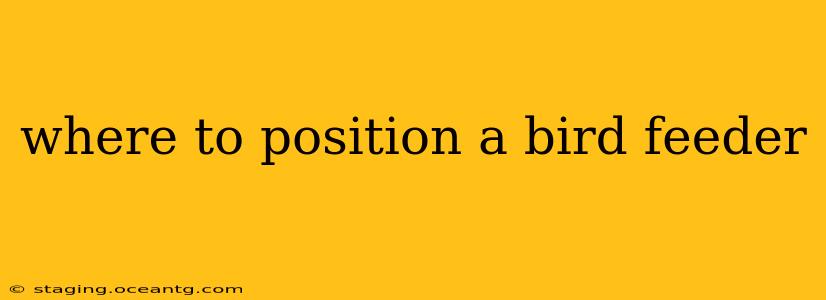Attracting birds to your backyard is a rewarding experience, offering hours of entertainment and a connection with nature. A key element in successful bird feeding is choosing the right location for your feeder. Placing it strategically maximizes bird activity and minimizes risks. This guide covers the optimal placement for bird feeders, addressing common questions and concerns.
How High Should a Bird Feeder Be?
The ideal height for your bird feeder depends on several factors, including the species of birds you hope to attract and the presence of predators. Generally, placing your feeder between 4 and 6 feet above the ground is a good starting point. This height provides sufficient clearance from ground predators like cats and raccoons while still allowing smaller birds easy access. However, if you have persistent predator issues, raising the feeder higher might be necessary. Consider using a pole-mounted feeder or hanging it from a tree branch that's out of reach of cats.
What is the Best Location for a Bird Feeder?
The best location for your bird feeder offers a balance of safety, visibility, and accessibility for birds. Here's what to consider:
- Visibility: Birds are less likely to approach a feeder hidden in dense foliage. Choose a location where the feeder is visible from several angles, providing birds with a clear approach.
- Shelter: While visibility is important, providing some level of protection from harsh weather elements is also crucial. A location near trees or shrubs can offer shelter from wind and rain, making birds feel more secure.
- Predator Protection: This is a vital consideration! Keep the feeder away from areas where cats can easily ambush birds. Maintain a distance from windows to avoid bird collisions. Consider using a feeder with a baffle to deter squirrels and other larger animals.
Should I Put My Bird Feeder Near a Window?
While placing your feeder near a window might seem convenient for viewing, it presents significant risks to birds. Birds, especially during feeding frenzies, can collide with windows, resulting in injury or death. If you want to position your feeder near a window, maintain a minimum distance of 10 feet. Consider adding window decals or streamers to help birds see the glass.
What is the Best Bird Feeder Placement to Avoid Squirrels?
Squirrels are notorious for raiding bird feeders. Here are some strategies to deter them:
- Squirrel-resistant feeders: Many feeders are specifically designed with cages or baffles to prevent squirrels from reaching the seeds.
- Pole-mounted feeders: Raising the feeder on a pole can make it more difficult for squirrels to access.
- Location: Avoid placing the feeder near trees or other structures that squirrels can easily jump onto.
How Far Apart Should Bird Feeders Be?
Spacing your feeders strategically can encourage more bird diversity. Keeping feeders too close together can lead to competition and aggression among birds. Generally, a distance of 25-50 feet between feeders provides enough space for various species to feed comfortably without causing conflict. Observe your birds; if you notice aggressive behavior near a feeder, increase the spacing.
Can I Put a Bird Feeder Under a Tree?
Positioning a bird feeder directly under a tree can offer some protection from the elements. However, it also poses risks. Low-hanging branches might provide convenient access points for squirrels and other predators. Furthermore, bird droppings might accumulate on the lower branches and create a messy situation. If you choose this location, ensure the feeder is sufficiently elevated and that any branches are out of reach of predators.
Should I Move My Bird Feeder Regularly?
While there’s no strict rule about moving your bird feeder frequently, occasional relocation can be beneficial. Moving it allows different areas of your yard to benefit from bird activity and seed distribution. It can also help to avoid soil contamination beneath the feeder from seed waste and droppings.
By carefully considering these factors and adapting them to your specific backyard environment, you can create a bird-friendly oasis that attracts a vibrant array of feathered visitors. Remember, consistent observation of your birds and their behaviour will guide you to the optimal feeder placement for your unique situation.
